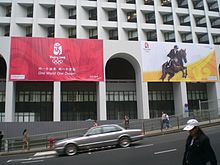
The Bank of China Tower is a skyscraper located in Central,Hong Kong. Located at 1 Garden Road on Hong Kong Island,the tower houses the headquarters of the Bank of China Limited. One of the most recognisable landmarks in Hong Kong,the building is notable for its distinct shape and design,consisting of triangular frameworks covered by glass curtain walls.

Central,also known as Central District,is the central business district of Hong Kong. It is located in the northeastern corner of the Central and Western District,on the north shore of Hong Kong Island,across Victoria Harbour from Tsim Sha Tsui,the southernmost point of Kowloon Peninsula. The area was the heart of Victoria City,although that name is rarely used today.

Cyberport is a business park in Southern District,Hong Kong,consisting of four office buildings,a hotel,and a retail entertainment complex. It describes itself as a digital technology community with over 1,800 digital and technology companies.
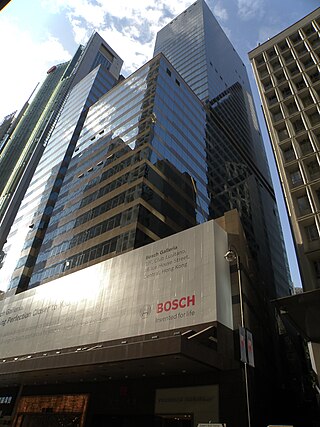
New World Development Company Limited (NWD),is a Hong Kong-based company focused on property,hotels,infrastructure and services and department stores. It was established on 29 May 1970 by Cheng Yu-tung. The company is publicly listed on the Stock Exchange of Hong Kong Limited since 23 November 1972 and is a constituent stock of Hong Kong Hang Seng Index.

The Chinese People's Liberation Army Forces Hong Kong Building is the headquarters building of the People's Liberation Army Hong Kong Garrison,located on Lung Wui Road,Admiralty,Hong Kong.
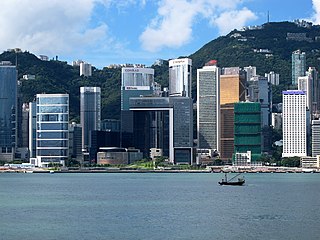
Admiralty is the eastern extension of the central business district on the Hong Kong Island of Hong Kong. It is located on the eastern end of the Central and Western District,bordered by Wan Chai to the east and Victoria Harbour to the north.

Sun Hung Kai Properties Limited (SHKP) is a listed corporation and one of the largest property developers in Hong Kong. The company's businesses include property sales,property rental,telecommunications,hotel operation,transport and logistics,and others. The company is controlled by the Kwok family trust,largely the Kwok brothers.

The Hong Kong Club Building is a 25-story office building located in between Chater Road and Connaught Road Central at the junction of Jackson Road,in Central,Hong Kong. The Hong Kong Club Building is currently in its third generation,in its second location. It is owned by the Hong Kong Club,which occupies 8 levels,while the other floors are leased for office use.
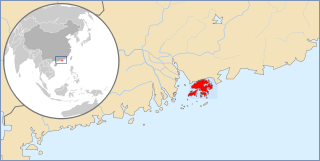
The issue of banknotes of the Hong Kong dollar is governed in the Special Administrative Region of Hong Kong by the Hong Kong Monetary Authority (HKMA),the governmental currency board and central bank of Hong Kong. Under licence from the HKMA,three commercial banks issue their own banknotes for general circulation in the region. Notes are also issued by the HKMA itself.

Public housing in Hong Kong is a set of mass housing programmes through which the Government of Hong Kong provides affordable housing for lower-income residents. It is a major component of housing in Hong Kong,with nearly half of the population now residing in some form of public housing. The public housing policy dates to 1954,after a fire in Shek Kip Mei destroyed thousands of shanty homes and prompted the government to begin constructing homes for the poor.

Tamar is the administrative centre of Hong Kong located in Admiralty. The headquarters of Hong Kong's Legislative Council and Central Government are located in Tamar. Adjacent to the island's financial heart at the Central harbourfront,the word Tamar is often used as a metonymy for the Government of Hong Kong.
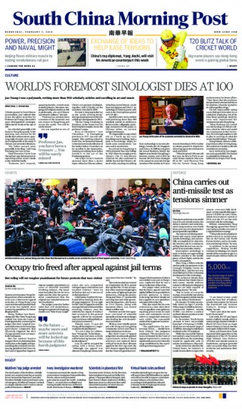
The South China Morning Post (SCMP),with its Sunday edition,the Sunday Morning Post,is a Hong Kong-based English-language newspaper owned by Alibaba Group. Founded in 1903 by Tse Tsan-tai and Alfred Cunningham,it has remained Hong Kong's newspaper of record since British colonial rule. Editor-in-chief Tammy Tam succeeded Wang Xiangwei in 2016. The SCMP prints paper editions in Hong Kong and operates an online news website that is blocked in mainland China.

Kai Tak Cruise Terminal is a cruise ship terminal on the former Kai Tak Airport runway in Hong Kong. Its completion date was delayed into 2013 due to re-tendering. Following an international competition,Foster + Partners was chosen to design the cruise terminal. The first ship berthed on 12 June 2013. The terminal has the capacity to berth two large 360-metre (1,180 ft) long vessels,which carry a total of 5,400 passengers and 1,200 crew,as well as anticipating the demands of cruise liners currently on the drawing board.

Central and Wan Chai Reclamation is a project launched by the government of Hong Kong since the 1990s to reclaim land for different purposes. This includes transportation improvements such as the Hong Kong MTR station,Airport Express Railway &Central-Wan Chai Bypass,as well as public recreation space such as the Central Harbourfront Event Space,Tamar Park and the Hong Kong Observation Wheel.
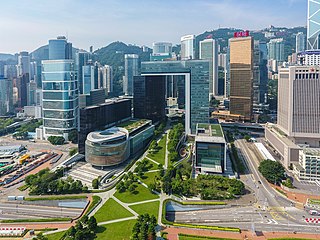
The Central Government Complex has been the headquarters of the Government of Hong Kong since 2011. Located at the Tamar site,the complex comprises the Central Government Offices,the Legislative Council Complex and the Office of the Chief Executive of Hong Kong. The complex has taken over the roles of several buildings,including the former Central Government Offices (CGO),Murray Building and the former Legislative Council Building.

Three Garden Road,Central,is an office building in Central,Hong Kong near Garden Road stop of the Peak Tram,completed in 1992 by the Great Eagle Group.

The Standard Chartered Bank Building is a skyscraper located in Central,Hong Kong. The tower rises 42 storeys and 191 metres (627 ft) in height. The building was completed in 1990. It was designed by architectural firm P &T Architects &Engineers Ltd.

Housing in Hong Kong varies by location and income. More than 7 million people live on about 1,108 km2 (427 mi2) of land in the region,making it one of the densest places in the world.

The Second term of Donald Tsang as Chief Executive of Hong Kong,officially referred to as "The 3rd term Chief Executive of Hong Kong" relates to the period of governance of Hong Kong since the transfer of sovereignty over Hong Kong,between 1 July 2007 and 30 June 2012. Former civil-servant Donald Tsang was the Chief Executive throughout the duration.
The Small House Policy was introduced in 1972 in Hong Kong. The objective was to improve the then prevailing low standard of housing in the rural areas of the New Territories. The Policy allows an indigenous male villager who is 18 years old and is descended through the male line from a resident in 1898 of a recognized village in the New Territories,an entitlement to one concessionary grant during his lifetime to build one house.


